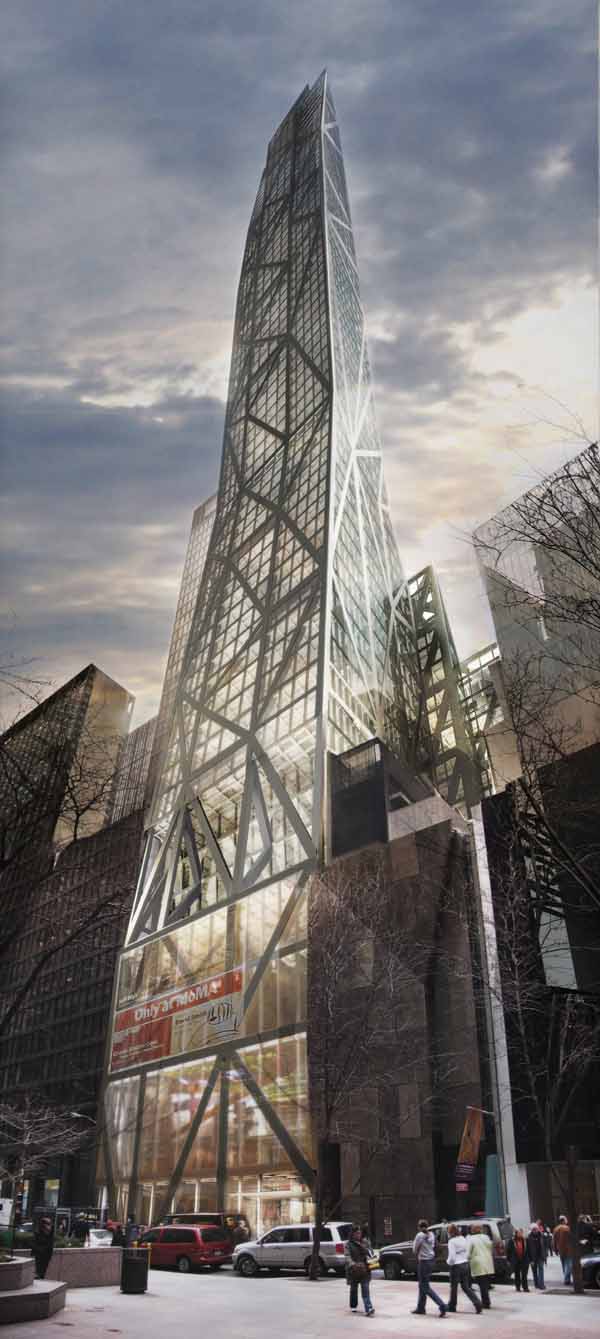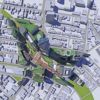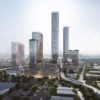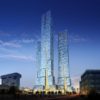After decades of being overshadowed by its big sister to the east, Jersey City is ready for the spotlight.
Once considered a place simply to pass through on the way to Manhattan, New Jersey’s second-largest municipality is making the transition from a gritty industrial city into one of America’s hottest real estate markets.
“Jersey City is like the actor who worked for 30 years and all of a sudden gets a great role and is nominated for an Academy Award,” says Bob Antonicello, president of Fair Lawn, New Jersey–based GRID Real Estate, a commercial brokerage specializing in redevelopment. “In real estate, the mantra usually is ‘location, location, location.’ For Jersey City, it’s ‘timing, timing, timing.’ ”
Jersey City’s real estate potential is being unlocked by developers who previously concentrated on Manhattan but who are now zeroing in on the 16 square miles (41 sq km) across the Hudson River. Some 5,600 residential units are under construction in Jersey City, upwards of 8,600 more are already approved, and more than 25,000 additional units are proposed. At present, 13 residential buildings are under construction in Jersey City, dozens more are planned, and scores more have been completed. Says Robert Cotter, Jersey City planning director: “Time frames are difficult because we don’t track the stuff getting built, but . . . I count 60 major buildings built or rehabbed since 2000—and that’s only at or near the Hudson River Waterfront, what we call ‘downtown.’ That number does not include small projects of under 50 units. That number does include 11,948 units, 7.2 million square feet [669,000 sq m] of office, 1 million square feet [93,000 sq m] of retail, and 19,701 parking spaces.”
The following are among the numerous projects underway in Jersey City:
A project by Edison, New Jersey–based Mack-Cali Realty Corporation, M2, near the firm’s Harborside mixed-use development on the Hudson River, is under construction. A 311-unit luxury apartment high rise at the Harsimus Cove Hudson-Bergen Light Rail station, M2 joins Marbella, an existing 38-story, 412-unit luxury high-rise apartment building in the heart of Jersey City that will be connected to M2 via a shared parking garage. M2 is scheduled to open in June 2016.
Trump Bay Street, a new, 50-story luxury residential tower, broke ground in May in the heart of Jersey City’s Powerhouse Arts District. The $193.5 million development is a partnership between KABR Group and developer Jared Kushner. (kabr group)
Trump Bay Street, a new, 50-story luxury residential tower, broke ground in May in the heart of Jersey City’s Powerhouse Arts District. The $193.5 million development is a partnership between KABR Group and developer Jared Kushner. (kabr group)
Mack-Cali and Hoboken-based partner Ironstate Development’s URL (Urban Ready Living) Harborside will sit on the waterfront. The venture is planned in two phases—a 69-story, 763-unit residential tower now under construction (URL Harborside 1) and two towers across the street. The first phase broke ground in January 2014 and is expected to be occupied in mid-2016. An elevated footbridge will connect the structures. When completed, URL Harborside will contain about 2,358 units.
Trump Bay Street, a $200 million–plus, 50-story, 447-unit luxury multifamily development, is under construction in the city’s Powerhouse Arts District. The district lies two blocks west of the Jersey City waterfront and is bound by Second Street, Marin Boulevard, Steuben Street, and Washington Street. Developed by a partnership between Ridgefield, New Jersey–based KABR Group and Kushner companies, the structure is expected to open in early 2017.
Bridgewater, New Jersey–based Kushner Real Estate (KRE) Group and Washington, D.C.–based National Real Estate Advisors’ 53-story, 538-unit luxury multifamily building, Journal Squared, began construction in January 2014. It is the first of three planned towers. Designed by New York City–based Hollwich Kushner Architecture DPC and Handel Architects of New York City, the building is expected to be completed in mid-2016.
Toll Brothers Apartment Living and AECOM Capital’s Provost Square is billed as the first component of a three-building complex that will include 925 residential units, a 550-seat performing arts center, and 45,000 square feet (4,200 sq m) of ground-floor retail space.
Changing Times
Located between Jersey City’s Marina and light-rail station in Liberty Harbor North, the 11-story, 422-unit luxury apartment building 18 Park opened in June 2014. The structure was designed by HWKN and Minno & Wasko Architects and Planners and is a project of KRE Group and Ironstate Development Company. (michael moran)
Located between Jersey City’s Marina and light-rail station in Liberty Harbor North, the 11-story, 422-unit luxury apartment building 18 Park opened in June 2014. The structure was designed by HWKN and Minno & Wasko Architects and Planners and is a project of KRE Group and Ironstate Development Company. (michael moran)
Thanks to its proximity to New York City, inexpensive land, and revitalizing neighborhoods, Jersey City is finally coming into its own. “The city is affordable, and you can be in midtown or downtown Manhattan in 15 minutes by PATH [Port Authority Trans-Hudson] train,” says Adam Altman, managing member of KABR Group. “Jersey City is evolving into its own sense of place with its own cultural activities, including the historic Loew’s Jersey Theatre and Mana Contemporary.”
Driving development are the city’s infrastructure and changing demographics led by millennials who want to live, work, and play in metropolitan areas, say developers, real estate firms, and city officials. With residential rents in Manhattan skyrocketing, the west bank of the Hudson is becoming an affordable alternative. According to Roseland, a subsidiary of Mack-Cali Realty, in New York City, depending on location, new Class A product can rent anywhere from $80 to $100 per square foot ($861 to $1,076 per sq m); in Jersey City, new Class A product is renting from $38 to $45 per square foot ($409 to $484 per sq m).
The average rent for a one-bedroom unit in Manhattan’s trendy Tribeca neighborhood is about $3,800 per month, or $63 per square foot ($678 per sq m). In Jersey City, however, a similar unit runs about $2,600 per month, or about $42 per square foot ($452 per sq m), says GRID’s Antonicello. “Residential units in Jersey City have competitive amenities packages that include state-of-the-art fitness centers, covered parking, swimming pools, dog walks, business centers, and more,” he adds. “And most offer the world-class views of Manhattan’s skyline and the Statue of Liberty.”
The 16 story, 348-unit 225 Grand, in Jersey City’s Liberty Harbor North neighborhood, was completed in 2010. The project was developed in collaboration between KRE Group and Ironstate Development Company, and was designed by HLW Architects. (kre group)
The 16 story, 348-unit 225 Grand, in Jersey City’s Liberty Harbor North neighborhood, was completed in 2010. The project was developed in collaboration between KRE Group and Ironstate Development Company, and was designed by HLW Architects. (kre group)
“Jersey City has terrific transportation,” says Jeffrey Persky, executive vice president of KRE Group. “And in Jersey City, you can rent a new, modern residence [with lots of amenities] for half the price [as] in Manhattan.”
Over the past few years, real estate firms such as KRE have erected a number of residential towers in Jersey City. “We built Grove Pointe—458 residential units and 67 condos at the Grove Street PATH station—and 225 Grand—348 units at Grand Street and Marin,” says Persky. “In July, we opened the 422-unit 18 Park, where we’ve leased 200 units in two months. That is phenomenal, since renting 30 units a month is considered good. The demand remains strong in Jersey City.”
Helping to spur that demand is an expanding creative class—advertising, media, and performing and visual arts—that was priced out of New York City, then Brooklyn, then the Long Island City neighborhood of westernmost Queens. “The millennials are spurring demand and are becoming the future of the city,” Antonicello says, “a future we couldn’t have imagined decades ago.”
History of the City
Adjacent to the Grove Street PATH station in Jersey City, Grove Pointe was completed in 2007 by KRE Group and National Real Estate Advisors. The 30-story building has 458 rental units and 67 condominiums. It was designed by DeWitt Tishman Architects. (kre group)
Adjacent to the Grove Street PATH station in Jersey City, Grove Pointe was completed in 2007 by KRE Group and National Real Estate Advisors. The 30-story building has 458 rental units and 67 condominiums. It was designed by DeWitt Tishman Architects. (kre group)
One of the original settlements of New Amsterdam, Jersey City was started with a land grant by the Dutch West India Company in 1630. It became a thriving hub of commerce in the 1800s with the opening of the 102-mile-long (164 km) Morris Canal, connecting Philthe lipsburg on the Delaware River with Jersey City on the Hudson River. Shipping and railroads were the major industries. But the railroads hit hard economic times and the working waterfront was abandoned. According to Cotter, the invention of the shipping container in 1955 killed the Jersey City waterfront, and the development of the Interstate Highway System killed the railroads, with Penn Central Railroad filing for bankruptcy in 1970 and closing forever in 1976. Rather than affecting a few blocks, the shipping and rail pullback hit half of downtown Jersey City. Residents fled, according to city officials.
Photos of Jersey City from the 1970s and 1980s depict entire blocks of desolate buildings. Recognizing that the shipping and railroad business would not return, municipal officials looked east and began laying the groundwork to lure financial firms across the Hudson River. The renaissance began on the sprawling, deserted waterfront. High-rise condos and shopping malls, including Newport Centre, sprouted up during the 1990s, followed by financial services firms, including Goldman Sachs and J.P. Morgan, and accelerated after the terrorist attacks of September 11, 2001.
“Manhattan was struggling at the time, and office rents were significantly cheaper in Jersey City,” explains James W. Hughes, dean of Rutgers University’s Edward J. Bloustein School of Planning and Public Policy in New Brunswick. “Jersey City had great linkages to New York City via PATH and the effective use of ferries, so it became a viable office market, surprising everyone.”
Roseland Property Company’s Marbella II, which broke ground in December 2013, is expected to be completed later next year. Located in the Newport/Powerhouse neighborhoods, the 38-story Marbella II will have 311 luxury units. (Roseland, A Mack-Cali Company)
Roseland Property Company’s Marbella II, which broke ground in December 2013, is expected to be completed later next year. Located in the Newport/Powerhouse neighborhoods, the 38-story Marbella II will have 311 luxury units. (Roseland, A Mack-Cali Company)
Two large mixed-use projects on the Jersey City waterfront—the LeFrak Organization’s Newport, a master-planned mixed-use community with retail, residential, office, and entertainment components that was started in the mid-1980s, with acreage acquired in 1984; and Mack-Cali Realty’s mixed-use office complex, Harborside, at Exchange Place—helped attract business from Manhattan.
“Soon, Jersey City was being called the Gold Coast and the sixth borough,” says Hughes. “Following the 2008 recession, the Jersey City office market softened considerably. It is still doing reasonably well but is having to adapt to nonfinancial firms, including media, advertising, and the like.” The city had to adapt to the 2008 financial crisis, when activity in the financial sector slowed.
Jersey City continues to offer less expensive office space. Mark L. Ravesloot, vice chairman of CBRE’s New York office, says that office rents in Jersey City are 56 percent lower than Manhattan’s midtown office market, 52 percent lower than midtown south, and 34 percent lower than the downtown Manhattan submarket.
Tax Incentives
A development of Roseland Property Company, the $240 million Monaco has 523 luxury rental units in two 50-story structures. The Monaco includes 12,300 square feet (1,142 sq m) of retail space. (Roseland, A Mack-Cali Company)
A development of Roseland Property Company, the $240 million Monaco has 523 luxury rental units in two 50-story structures. The Monaco includes 12,300 square feet (1,142 sq m) of retail space. (Roseland, A Mack-Cali Company)
But that is not the only allure of Jersey City today. The state’s Grow N.J. incentive program provides a credit against the state corporate tax of $7,000 to $10,750 per employee per year for up to a decade—in effect, providing free rent for companies moving to the state, says Ravesloot. “Based on an occupancy of one person per 175 rentable square feet [RSF]—which is the typical standard—the Grow N.J. benefit is worth between $40 per RSF and $61.43 per RSF per year for up to a decade,” he explains. “This benefit more than wipes out any rental expense for the first ten years of a 15-year lease. It’s no wonder companies are moving to Jersey City.”
Indeed, incentives have become central to Jersey City’s growth. It is one of nine municipalities in the state eligible for Urban Transit Hub Tax Credits by the state’s Economic Development Authority. In addition, Hughes says, New Jersey’s Business Employment Incentive Program provides rebates of the state income taxes that are paid on each project.
“Jersey City sometimes provides incentives in the form of PILOT [payment in lieu of taxes] and tax abatements to jump-start new projects,” says Dean P. Marchetto, founding principal at the Hoboken architecture firm of Marchetto Higgins Stieve. “Since Jersey City recognizes that density is critical to creating a great urban environment, it often provides density bonuses to create public improvements such as parks and mobility infrastructure. The Jersey City planning office under Bob Cotter works closely with all the landowners and developers to ensure a successful and balanced plan.”
Each deal is structured differently but typically allows a developer to forgo a certain portion of state, property, school, or county taxes for a set number of years. For example, the city council awarded Trump Bay Street, now under construction, a five-year tax abatement. Under the plan, the developers pay no taxes for the first year and 20 percent of the normal tax payments the following year. That amount increases by 20 percent until the sixth year, when the abatement expires.
“Most states have similar incentives, including provisions for municipalities to issue payments in lieu of taxes,” says Hughes. “What makes the success of Jersey City difficult to replicate is that it’s essentially attached to one of the hottest real estate markets in the country.”
Incentives are now being used to direct development to inner areas like Journal Square, which has a PATH station three stops from Manhattan, and the Bergen-Lafayette neighborhoods, which have several light-rail stops.
Mack-Cali and Ironstate Development Company are building URL Harborside (Urban Ready Living) on the Jersey City waterfront. The venture will be in two phases—a single residential tower now under construction (URL Harborside 1) and two additional towers across the street in a second phase. The structures will be connected by an elevated footbridge. When completed, URL Harborside will contain about 2,358 apartments. (Mack-Cali realty corporation)
Mack-Cali and Ironstate Development Company are building URL Harborside (Urban Ready Living) on the Jersey City waterfront. The venture will be in two phases—a single residential tower now under construction (URL Harborside 1) and two additional towers across the street in a second phase. The structures will be connected by an elevated footbridge. When completed, URL Harborside will contain about 2,358 apartments. (Mack-Cali realty corporation)
“Neighborhoods like Journal Square and Bergen-Lafayette are part of the natural progression of development,” says Mayor Steven M. Fulop. “We have already seen significant interest in these areas. Journal Square is a major intermodal transportation center, and Bergen-Lafayette is more reachable because of the Hudson-Bergen Light Rail stations. They are not quite at the tipping point, though, so aggressive zoning and incentives are needed to push these areas forward.”
The city has already approved 3,841 units of residential space, 311,000 square feet (29,000 sq m) of retail uses, and 41,000 square feet (3,800 sq m) of offices in the Journal Square district, says Antonicello. Nearly 1,000 residential units are under construction, and 372 units were recently completed.
The developers who took the risk first will get the biggest incentives because they are laying the initial anchor, adds Fulop. “The incentives are not just tax abatements but aggressive zoning, which is in line with the state plan of New Jersey,” he says. “The New Jersey state plan promotes high-density development around transportation centers.”
In addition, developers can build taller buildings in Journal Square than on the waterfront, says KRE’s Persky. “The city is creating pockets of development where it seeks denser development and real estate developers looking for larger projects that would fit there.”
That strategy appears to be working. KRE, for instance, is locating its Journal Squared project behind the Journal Square PATH station. “Journal Squared is our most ambitious project,” says Persky. The three-phase project will feature 1,840 market-rate residential units as well as 36,000 square feet (3,300 sq m) of retail space. “You will be able to walk out of the train station and right into Journal Squared.”
Also in Journal Square, KABR Group plans to transform the former Jersey Journal building into a mixed-use development. “We are in the process of assessing the situation and working with the city to receive proper approvals and go forward. It will be a residential project with a retail component, both of which will create more of a sense of place,” Altman says.
Mack-Cali and Ironstate Development Company are building URL Harborside (Urban Ready Living) on the Jersey City waterfront. The venture will be in two phases—a single residential tower now under construction (URL Harborside 1) and two additional towers across the street in a second phase. The structures will be connected by an elevated footbridge. When completed, URL Harborside will contain about 2,358 apartments. (Mack-Cali realty corporation)
Mack-Cali and Ironstate Development Company are building URL Harborside (Urban Ready Living) on the Jersey City waterfront. The venture will be in two phases—a single residential tower now under construction (URL Harborside 1) and two additional towers across the street in a second phase. The structures will be connected by an elevated footbridge. When completed, URL Harborside will contain about 2,358 apartments. (Mack-Cali realty corporation)
Jersey City’s master plan provides significant opportunity to create real estate product in a number of other areas, says Marshall B. Tycher, copresident of Short Hills–based Roseland, a subsidiary of Mack-Cali Realty. “The city feels there is no reason for the waterfront to be the sole beneficiary of the demand, and these submarkets will continue to develop and will be transformative,” Tycher explains. “If job growth continues, the strain of affordability in Manhattan will continue to generate demand for apartments in Jersey City.”
In addition to the development of residential, retail, and office space and the restoration of existing brownstones, new restaurants and cafés are popping up throughout town, and cultural amenities are being created. The 1 million-square-foot (93,000 sq m) Mana Contemporary opened three years ago in a 1920s-era manufacturing building to provide services, spaces, and programming for artists, art collectors, and performers. One of the state’s most opulent movie venues, Loew’s Jersey Theatre—built in 1929, slated for demolition in 1987, but saved by residents who in 1987 sought to restore the movie house—is being restored to its original grandeur in an effort to attract theatergoers from the city and from Manhattan. Although events have been held at the theater and a new management company is being brought in, the types of events to be scheduled once the restoration is complete have not been determined.
Roseland and Mack-Cali have more sites in Jersey City that could be developed. “We will continue to study the highest and best use for our portfolio,” Tycher says. “Job growth in the economy has finally resumed and demand for apartments has expanded with the jobs. Manhattan apartment rents for new product exceed $90 per square foot, so new apartments in Jersey City with rents at $40 to $45 per square foot are far more affordable. With PATH and the ferries, transportation is competitive with [that available in] places like Long Island City and other comparable markets across the East River.”
The Takeaway
With 1.25 million square feet (116,000 sq m) of office space and 42 stories of art-deco architecture, 101 Hudson Street is one of the most recognized buildings in the revitalized Jersey City. (Mack-Cali realty corporation)
With 1.25 million square feet (116,000 sq m) of office space and 42 stories of art-deco architecture, 101 Hudson Street is one of the most recognized buildings in the revitalized Jersey City. (Mack-Cali realty corporation)
What can others learn from Jersey City’s transformation? The need for thoughtful and continuous planning, says Fulop. “When developing a city, it is important to look at the entire city and the big picture and develop a vision that includes all aspects of community living, including cultural and recreational amenities and parks and public spaces. Incentives must be used wisely and
. . . to motivate developers to take some risk just outside of their comfort zone.”
Good planning and public outreach also are critical for municipalities that want to attract growth, says Marchetto. “It is important to educate the public about the benefits of growth,” he adds. “Some cities and inner-ring suburban communities are afraid of growth largely because it can be associated with congestion, affordable housing, and an increased burden on school systems. An incentivized, balanced plan with a form-based code and high-quality visuals is essential to gaining support from communities and neighborhoods that might be afraid of growth.”
Residents should embrace density, says Cotter, Jersey City’s planning director. “Density is good,” he continues. “People today want to live in a dense, walkable environment, and this is what we are seeing in Jersey City. Thanks to mass transit, we’ve built 18 million square feet [2.3 million sq m] of Class A office space and over 25,000 dwelling units without adding a single lane of highway.”
Acquired in 1996, the 5.5-acre (2.2 ha) Harborside is currently undergoing significant renovations, featuring high-end finishes, lighting, and appointments; additional dining options; and increased green spaces. (Mack-Cali realty corporation)
Acquired in 1996, the 5.5-acre (2.2 ha) Harborside is currently undergoing significant renovations, featuring high-end finishes, lighting, and appointments; additional dining options; and increased green spaces. (Mack-Cali realty corporation)
Density is critical to making vibrant urban places, Cotter says. “Planning is very important, but you also need to be flexible,” he says. “We are market-driven in the public interest. It’s foolish to fight the market because the market is us.”
Jersey City now offers a rich amenity base of restaurants, hotels, marinas, fitness facilities, services, and retail—plus high-quality office buildings to serve the needs of the new economy, says Mitchell E. Hersh, president and chief executive officer of Mack-Cali Realty and chairman and chief executive officer of its Roseland subsidiary. “Together with the emergence of a significant residential community serving the ever-evolving needs and desires of the millennial workforce,” he says, “Jersey City is becoming the new way of working, living, and playing in the region.”
Mike Sheridan is a freelance writer based in Parsippany, New Jersey.










